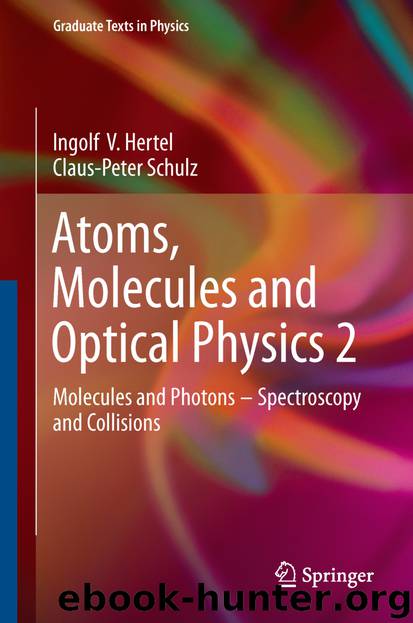Atoms, Molecules and Optical Physics 2 by Ingolf V. Hertel & Claus-Peter Schulz

Author:Ingolf V. Hertel & Claus-Peter Schulz
Language: eng
Format: epub
Publisher: Springer Berlin Heidelberg, Berlin, Heidelberg
5.8.3 TPES, PFI, ZEKE, KETOF, MATI
If one compares the photoelectron spectra shown above with optical spectra which we have seen in previous sections of this chapter, one notices the significantly poorer energy resolution of PES – essentially a consequence of the fundamentally different properties of electrons and photons: no electron monochromator can ever reach the resolution which is available today with optical spectroscopy. Nevertheless, energy selective electron detection is essential for the spectroscopy of ionization processes. Hence, numerous efforts have been made since the early days of PES to improve electron energy resolution or to combine PES somehow with the advantages of optical spectroscopy. One basic concept has finally turned out to be successful: to record only electrons that are ejected at the energetic threshold of each ionization process, starting from a well defined initial state with quantum numbers (γ′′v′′N′′) and leading to the final quantum numbers (γ′v′N′) according to (5.49). Thus, if one detects only electrons of practically negligible kinetic energies, these transitions can be determined with optical precision by just tuning the ionizing wavelength. One speaks of threshold photoelectron spectroscopy (TPES).
To achieve zero kinetic energy detection, one exploits the fact that photoelectrons with finite kinetic energy and momentum are emitted essentially into the whole solid angle of 4π. If one extracts them from the ionization volume with only a small electric field, and limits the detection angle, the collection efficiency will increase with decreasing initial kinetic energy (steradiancy discrimination). This technique can be applied with continuous (discharge lamps, X-ray tubes) or quasi-continuous light sources (synchrotron radiation in multi bunch mode). Early experiments of this kind, have already been performed by Baer et al. (1969), and a particularly efficient TPES detector has been reported by Cvejanov and Read (1974). With later improvements by King et al. (1987) the scheme is still used today very successfully (Sztaray and Baer 2003; Couto et al. 2006; Eland 2009); in these spectrometers sophisticated electron optics extract threshold electrons (from a nearly field free ionization volume) with high efficiency and image them according to their energy onto a position sensitive detector (with such devices one obtains today electron energy resolutions in the sub- range; see e.g. Baer et al. 2012). We shall come back to this in Sect. 5.8.5.
Alternatively one works with pulsed laser sources (laser pulses from to , or synchrotron radiation in the single bunch mode). In this case the time of ionization is well defined and electrons are extracted with some delay from the ionization volume (pulsed field ionization, PFI). Ideally, the timing is set such that all electrons with finite kinetic energy have left the ionization volume and only zero kinetic energy electrons are collected. This method has been used for the first time by Müller-Dethlefs et al. (1984) as zero kinetic energy (ZEKE) photoelectron spectroscopy. A schematic is shown and explained in Fig. 5.48.
Fig. 5.48Principle of detecting ZEKE photoelectrons and discriminating against nearly ZEKE electrons according to Müller-Dethlefs and Schlag (1991). In the example shown an extraction field is applied to the originally field free interaction region after 1 μs.
Download
This site does not store any files on its server. We only index and link to content provided by other sites. Please contact the content providers to delete copyright contents if any and email us, we'll remove relevant links or contents immediately.
| Automotive | Engineering |
| Transportation |
Whiskies Galore by Ian Buxton(41935)
Introduction to Aircraft Design (Cambridge Aerospace Series) by John P. Fielding(33085)
Small Unmanned Fixed-wing Aircraft Design by Andrew J. Keane Andras Sobester James P. Scanlan & András Sóbester & James P. Scanlan(32763)
Craft Beer for the Homebrewer by Michael Agnew(18194)
Turbulence by E. J. Noyes(7977)
The Complete Stick Figure Physics Tutorials by Allen Sarah(7334)
Kaplan MCAT General Chemistry Review by Kaplan(6897)
The Thirst by Nesbo Jo(6877)
Bad Blood by John Carreyrou(6581)
Modelling of Convective Heat and Mass Transfer in Rotating Flows by Igor V. Shevchuk(6406)
Learning SQL by Alan Beaulieu(6235)
Weapons of Math Destruction by Cathy O'Neil(6206)
Man-made Catastrophes and Risk Information Concealment by Dmitry Chernov & Didier Sornette(5951)
Digital Minimalism by Cal Newport;(5700)
Life 3.0: Being Human in the Age of Artificial Intelligence by Tegmark Max(5506)
iGen by Jean M. Twenge(5384)
Secrets of Antigravity Propulsion: Tesla, UFOs, and Classified Aerospace Technology by Ph.D. Paul A. Laviolette(5330)
Design of Trajectory Optimization Approach for Space Maneuver Vehicle Skip Entry Problems by Runqi Chai & Al Savvaris & Antonios Tsourdos & Senchun Chai(5036)
Pale Blue Dot by Carl Sagan(4949)
